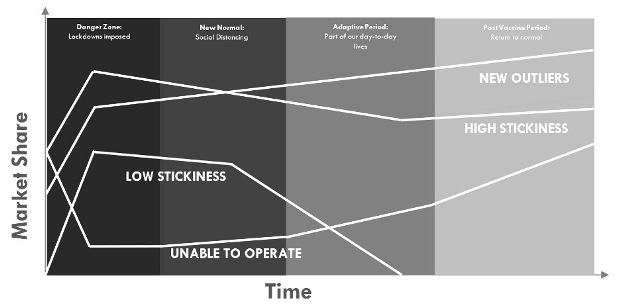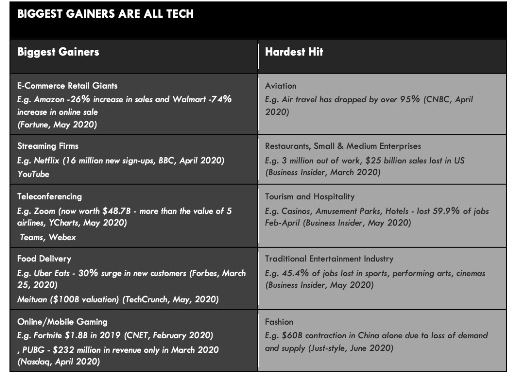COVID–19 is accelerating the technology takeover
By Shanil Fernando
The COVID-19 pandemic has revealed a great deal of vulnerabilities, and technology has proved to be an invaluable tool. Be it e-education, work from home tools, or essential services, our reliance on technology has deepened during the pandemic.
The four stages of pandemic behaviour
The patterns of altered behaviour can be divided into four stages. The Danger Zone is the period when the country goes into lockdown to try to contain the virus and flatten the curve. What follows is the New Normal; when countries try to open up a little while continuing to keep schools closed, work from home (WFH) and maintain social distancing. Then, we adapt to the virus, and return to more normal lives having developed a deeper understanding of how to live with the virus. Finally, after a vaccine is discovered, scaled and distributed, our behaviour can return to how it was.
We have seen the reactions of different companies, and can predict certain trends:

The first group of companies are completely unable to operate in the danger zone, such as companies in the travel, hospitality and ride sharing industries. These companies have suffered predominantly because they rely on direct services to people.
Companies with low long-term stickiness prop themselves up during the pandemic by creating a simple business that addresses new needs. They take advantage large companies’ struggle to react effectively. Ultimately, these companies lose market share due to a lack of customer experience. Larger players also catch up eventually.
Businesses with high stickiness see increased patronage during lockdown, and only a small drop afterwards. Ultimately, the momentum gained through new customers may allow them to continue to grow their customer base, even after the lockdown ends.
The biggest successes though are the new outliers whose business is based on changing consumer behaviours. Once behaviour has been changed, they feel comfortable continuing to operate that way post-lockdown.
Two Sri Lankan companies that succeeded in this environment are PickMe Delivery and oDoc, with the latter, which provides telemedicine software, seeing a 374% increase in new customer registrations during the lockdown period in March growing at 10% per day. They became the official telemedicine provider for the government of Sri Lanka and released an online COVID-19 symptoms checker. The adoption of video-based consultations has increased, and some patients may now prefer this convenience.
The digitization acceleration
According to Forbes, e-commerce retail orders in the US have increased by 146% while revenue has increased by 68% during this pandemic. But it isn’t just retail where e-commerce has exploded. If this trend continues, US online grocery sales are set to double by 2021 from $14.2 billion to $29.7 billion.
E-learning services have grown too. Google Classroom alone has experienced a 150% increase in its user base, on top of a pre-pandemic prediction by Forbes that the e-learning market would reach $325 Billion by 2025.
The digitization of banking has seen a significant a shift.In many countries, the use of ATMs has dropped by 60% while 63% of customers have tried out mobile banking applications.
The pre-pandemic AI and Automation acceleration has increased, proving useful in handling unforeseen loads in critical situations – as chat-bots deal with high traffic in the healthcare sector and beyond. The deployment of robotics in supply chain management has also allowed work to proceed with minimal direct human interaction.

The shorter supply chain
Companies have simplified sales processes, merging B2B and B2C supply chains in order to get products to consumers faster. Many brick and mortar establishments have been unable to remain open, so manufacturers and suppliers are selling directly to consumers online.
Changes to how businesses run
Fears that employees working remotely will affect productivity have been quelled, with 88% of employers encouraging teams to WFH. In most cases productivity did not decrease meaningfully; provided the prerequisite hardware tools and cloud architecture were put in place.
Business apps which facilitate remote work reached 62 million downloads from 14-21 March. Video calls over Microsoft Teams have increased by 1000% and Zoom has reached a market capitalization of $48.78 Billion as usage went up by 3000%.
Small companies may forgo physical office spaces and opt to use co-working spaces for meetings, while their teams WFH. Remote work can also mean that hiring pools have become global as geography ceases to be a major consideration.
Tech and the customer experience
Although it is easy to misinterpret this as a phenomenon brought about by the pandemic, a closer analysis reveals that it is simply an acceleration of a trend: the increased use of tech to meet customer needs.
It isn’t a question of tech vs. non-tech, but a question of how technology can empower a company to provide superior customer experience. Although we may perceive the trend as a ‘tech-takeover’, it is really a ‘customer-experience’ takeover driven by technology – being able to adapt to changing behaviour patterns of the customer will define the success of the company.

-Shanil Fernando is the Co-founder & Managing Director, Sysco LABS


